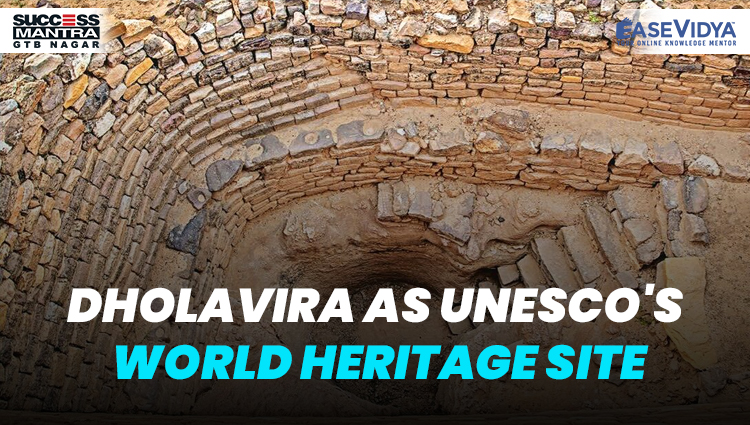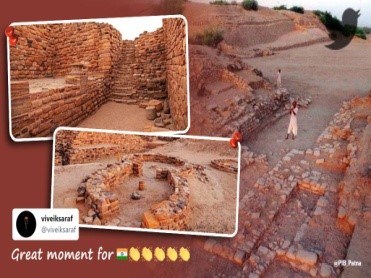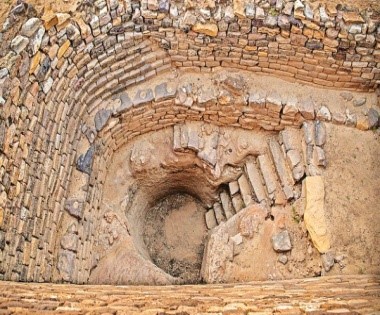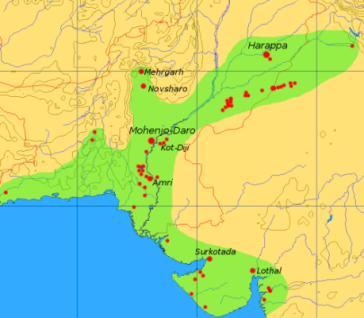
DHOLAVIRA AS UNESCO WORLD HERITAGE SITE
DHOLAVIRA AS UNESCO'S WORLD HERITAGE SITE

Recently, UNESCO has announced the Harappan city of Dholavira in Gujarat as India’s 40th world heritage site. It is the first site of Indus Valley Civilisation (IVC) in India to be included on the coveted list. With this successful nomination, India now enters the Super-40 club for World Heritage Site inscriptions. Apart from India, Italy, Spain, Germany, China and France have 40 or more World Heritage sites. India has 40 world heritage sites overall, which includes 32 cultural, 7 natural and one mixed property. Ramappa Temple (Telangana) was India's 39th World Heritage Site.
ABOUT THE DHOLAVIRA IN GUJARAT
It is one of the most remarkable and well-preserved urban settlements in South Asia. It was discovered in 1968 by archaeologist Jagat Pati Joshi. After Mohen-jo-Daro, Ganweriwala and Harappa in Pakistan and Rakhigarhi in Haryana of India, Dholavira is the fifth largest metropolis of Indus Valley Civilization (IVC). IVC flourished around 2,500 BC, in the western part of South Asia, what today is Pakistan and Western India. It was basically an urban civilization and the people lived in well-planned and well-built towns, which were also the centers for trade.
The site contains ruins of an ancient IVC/Harappan city. It comprises two parts: a walled city and a cemetery to the west of the city. The walled city consists of a fortified Castle with attached fortified Bailey and Ceremonial Ground, and a fortified MiddleTown and a Lower Town.
A series of reservoirs are found to the east and south of the Citadel.
LOCATION OF THE SITE

The ancient city of Dholavira is an archaeological site at Kachchh District, in the state of Gujarat, which dates from the 3rd to mid-2nd millennium BCE. Dholavira’s location is on the Tropic of Cancer. It is located on Khadir bet island in the Kachchh Desert Wildlife Sanctuary in the Great Rann of Kachchh. Unlike other Harappan antecedent towns normally located near to rivers and perennial sources of water, the location of Dholavira in the island of Khadir bet. This was strategic to harness different mineral and raw material sources (copper, shell, agate-carnelian, steatite, lead, banded limestone, among others). It also facilitated internal as well as external trade to the Magan (modern Oman peninsula) and Mesopotamian regions.
ARCHEOLOGICAL FINDINGS IN DHOLAVIRA
Artifacts that were found here include terracotta pottery, beads, gold and copper ornaments, seals, fish hooks, animal figurines, tools, urns, and some imported vessels. Remains of a copper smelter indicate Harappans, who lived in Dholavira, knew metallurgy. It is believed that traders of Dholavira used to source copper ore from present-day Rajasthan and Oman and UAE and exported finished products. It was also a hub of manufacturing jewellery made of shells and semi-precious stones, like agate and used to export timber. 10 large stone inscriptions, carved in Indus Valley script, perhaps the world’s earliest sign board. Near the ancient city is a fossil park where wood fossils are preserved. Unlike graves at other IVC sites, no mortal remains of humans have been discovered at Dholavira.
DISTINCT FEATURES OF THE DHOLAVIRA SITE
- Cascading series of water reservoirs.
- Outer fortification.
- Two multi-purpose grounds, one of which was used for festivities and other as a marketplace.
- Nine gates with unique designs.
- Funerary architecture featuring tumulus — hemispherical structures like the Buddhist Stupas.
- Multi-layered defensive mechanisms, extensive use of stone in construction and special burial structures.
Decline of Dholavira: Its decline also coincided with the collapse of Mesopotamia, indicating the integration of economies. Harappans, who were maritime people, lost a huge market, affecting the local mining, manufacturing, marketing and export businesses once Mesopotamia fell. Dholavira entered a phase of severe aridity due to climate change and rivers like Saraswati drying up. Due to a drought-like situation, people started migrating toward the Ganges valley or towards south Gujarat and further beyond in Maharashtra. Further, the Great Rann of Kutch, which surrounds the Khadir island on which Dholavira is located, used to be navigable, but the sea receded gradually and the Rann became a mudflat.
OTHER HARAPPAN SITES IN GUJARAT

- Lothal: Before Dholavira was excavated, Lothal, in Saragwala village on the bank of Sabarmati in Dholka taluka of Ahmedabad district, was the most prominent site of IVC in Gujarat. It was excavated between 1955 and 1960 and was discovered to be an important port city of the ancient civilisation, with structures made of mud bricks. From a graveyard in Lothal, 21 human skeletons were found. Foundries for making copperware were also discovered. Ornaments made of semi-precious stones, gold etc. were also found from the site.
- Rangpur on the bank of Bhadar river in Surendranagar district was the first Harappan site in the state to be excavated.
- Rojdi in Rajkot district, Prabhas near Veraval in Gir Somnath district.
- Lakhabaval in Jamnagar, and Deshalpar in Bhuj taluka of Kutch are among other Harappan sites in the state.
Other World Sites in Gujarat: Other than Dholavira, there are 3 UNESCO World Heritage Sites in Gujarat: Historic city of Ahmedabad, Rani ki Vav, Patan, Champaner & Pavagadh.
TEST YOURSELF
Q.1 Recently, which of the following sites of the Indus Valley civilization have been added to the UNESCO'S World Heritage site list?
- Kalibangan
- Lothal
- Dholavira: ANSWER
- Banawali
Q.2 Consider the given statements & state which of the following is/are incorrect in the reference to the above-mentioned passage?
- UNESCO has announced the Harappan city of Banawali in Gujarat as India’s 40th world heritage site.
- India now enters the Super-40 club for World Heritage Site inscriptions.
- Apart from India, the United States, Spain, Germany, Indonesia and France have 40 or more World Heritage sites.
- I & III follows: ANSWER
- Only III follows
- II & III follows
- None of the following
Q.3 Which of the French Civil servant who is currently serving as the Director General of UNESCO?
- Irina Bokova
- Audrey Azoulay: ANSWER
- Audrey Hepburn
- None of the following
Q.4 Consider the given options and state which of the following Indus valley civilization sites is currently located in Gujarat?
- Mohenjo-daro
- Kalibangan
- Lothal: ANSWER
- Chanhudaro
- Lothal: ANSWER
Q.5 Consider the following statements & state which of the given statements is/are incorrect in the context of the UNESCO'S World Heritage Sites?
- UNESCO World Heritage Site is a place that is recognized by the United Nations Educational, Scientific and Cultural Organization as of distinctive cultural or physical importance.
- This is exemplified by the Convention regarding the Protection of the World Cultural and Natural Heritage, accepted by UNESCO in 1956: ANSWER
- The list of World Heritage Sites is maintained by the international 'World Heritage Programme', administered by the UNESCO World Heritage Committee.
- None of the following












qbokevfor
DHOLAVIRA AS UNESCO'S WORLD HERITAGE SITE | Read Daily Article Editorials Only On Success Mantra Blog | Daily Article | Monthly Article | Weekly Article | Yearly Article | Most Requesting Articles | Legal Awareness Articles | Current Affairs | Passage Based Current Affairs | One Linear Current Affairs | Current Affairs For CLAT | Current Affairs For AILET | Current Affairs For Slat | Legal Aptitude Current Affairs | Law Current Affairs | Current Event | Current Affairs Pdf | Current Affairs Pdf In English | Current Affairs Pdf Free Download | Current Affairs MCQ | Current Affairs MCQS | Current Affairs Work Sheet | Current Affairs UPSC | Current Affairs BBA | Current Affairs BCA | Current Affairs BJMC | Current Affairs NCHMJEE | Daily Editorial | Monthly Editorial | Weekly Editorial | Yearly Editorial | Most Asking Editorials | Legal Awareness Editorials | Current Editorial | Passage Based Current Editorial | One Linear Current Editorial | Current Editorial For CLAT | Current Editorial For AILET | Current Editorial For Slat | Legal Aptitude Current Editorial | Law Current Editorial | Current Event | Current Editorial Pdf | Current Editorial Pdf In ENGLISH | Current Editorial Pdf Free Download | Current Editorial MCQ | Current Editorial MCQS | Current Editorial Work Sheet | Current Editorial UPSC | Current Editorial BBA | Current Editorial BCA | Current Editorial BJMC | Current Editorial NCHMJEE | Latest News In India | Latest News In Hindi | Latest News Delhi | Latest News Today India | Latest News Live | 3 Latest News | Latest News Today Delhi | Latest News Aajtak | News Articles India | News Articles For Students | News Articles 2020 | News Articles In English | News Articles In Hindi | News Article Example | Short News Articles | News Article Meaning | Success Mantra Delhi | CLAT Coaching In Delhi | Best CLAT Du LLB Institute In Delhi | Read Daily Article Editorials Only On Success Mantra Blog qbokevfor http://www.gyfzx74cq255bjw4kx7nu92576tj3818s.org/ [url=http://www.gyfzx74cq255bjw4kx7nu92576tj3818s.org/]uqbokevfor[/url] <a href="http://www.gyfzx74cq255bjw4kx7nu92576tj3818s.org/">aqbokevfor</a>
yntsjgofwx
DHOLAVIRA AS UNESCO'S WORLD HERITAGE SITE | Read Daily Article Editorials Only On Success Mantra Blog | Daily Article | Monthly Article | Weekly Article | Yearly Article | Most Requesting Articles | Legal Awareness Articles | Current Affairs | Passage Based Current Affairs | One Linear Current Affairs | Current Affairs For CLAT | Current Affairs For AILET | Current Affairs For Slat | Legal Aptitude Current Affairs | Law Current Affairs | Current Event | Current Affairs Pdf | Current Affairs Pdf In English | Current Affairs Pdf Free Download | Current Affairs MCQ | Current Affairs MCQS | Current Affairs Work Sheet | Current Affairs UPSC | Current Affairs BBA | Current Affairs BCA | Current Affairs BJMC | Current Affairs NCHMJEE | Daily Editorial | Monthly Editorial | Weekly Editorial | Yearly Editorial | Most Asking Editorials | Legal Awareness Editorials | Current Editorial | Passage Based Current Editorial | One Linear Current Editorial | Current Editorial For CLAT | Current Editorial For AILET | Current Editorial For Slat | Legal Aptitude Current Editorial | Law Current Editorial | Current Event | Current Editorial Pdf | Current Editorial Pdf In ENGLISH | Current Editorial Pdf Free Download | Current Editorial MCQ | Current Editorial MCQS | Current Editorial Work Sheet | Current Editorial UPSC | Current Editorial BBA | Current Editorial BCA | Current Editorial BJMC | Current Editorial NCHMJEE | Latest News In India | Latest News In Hindi | Latest News Delhi | Latest News Today India | Latest News Live | 3 Latest News | Latest News Today Delhi | Latest News Aajtak | News Articles India | News Articles For Students | News Articles 2020 | News Articles In English | News Articles In Hindi | News Article Example | Short News Articles | News Article Meaning | Success Mantra Delhi | CLAT Coaching In Delhi | Best CLAT Du LLB Institute In Delhi | Read Daily Article Editorials Only On Success Mantra Blog [url=http://www.gctua27f0f27py65qbsu41732yu527a5s.org/]uyntsjgofwx[/url] <a href="http://www.gctua27f0f27py65qbsu41732yu527a5s.org/">ayntsjgofwx</a> yntsjgofwx http://www.gctua27f0f27py65qbsu41732yu527a5s.org/
kycplzyc
DHOLAVIRA AS UNESCO'S WORLD HERITAGE SITE | Read Daily Article Editorials Only On Success Mantra Blog | Daily Article | Monthly Article | Weekly Article | Yearly Article | Most Requesting Articles | Legal Awareness Articles | Current Affairs | Passage Based Current Affairs | One Linear Current Affairs | Current Affairs For CLAT | Current Affairs For AILET | Current Affairs For Slat | Legal Aptitude Current Affairs | Law Current Affairs | Current Event | Current Affairs Pdf | Current Affairs Pdf In English | Current Affairs Pdf Free Download | Current Affairs MCQ | Current Affairs MCQS | Current Affairs Work Sheet | Current Affairs UPSC | Current Affairs BBA | Current Affairs BCA | Current Affairs BJMC | Current Affairs NCHMJEE | Daily Editorial | Monthly Editorial | Weekly Editorial | Yearly Editorial | Most Asking Editorials | Legal Awareness Editorials | Current Editorial | Passage Based Current Editorial | One Linear Current Editorial | Current Editorial For CLAT | Current Editorial For AILET | Current Editorial For Slat | Legal Aptitude Current Editorial | Law Current Editorial | Current Event | Current Editorial Pdf | Current Editorial Pdf In ENGLISH | Current Editorial Pdf Free Download | Current Editorial MCQ | Current Editorial MCQS | Current Editorial Work Sheet | Current Editorial UPSC | Current Editorial BBA | Current Editorial BCA | Current Editorial BJMC | Current Editorial NCHMJEE | Latest News In India | Latest News In Hindi | Latest News Delhi | Latest News Today India | Latest News Live | 3 Latest News | Latest News Today Delhi | Latest News Aajtak | News Articles India | News Articles For Students | News Articles 2020 | News Articles In English | News Articles In Hindi | News Article Example | Short News Articles | News Article Meaning | Success Mantra Delhi | CLAT Coaching In Delhi | Best CLAT Du LLB Institute In Delhi | Read Daily Article Editorials Only On Success Mantra Blog kycplzyc http://www.g79qm8ofalj2ulv7s9930b7z80c2516zs.org/ [url=http://www.g79qm8ofalj2ulv7s9930b7z80c2516zs.org/]ukycplzyc[/url] <a href="http://www.g79qm8ofalj2ulv7s9930b7z80c2516zs.org/">akycplzyc</a>
nohqrziq
DHOLAVIRA AS UNESCO'S WORLD HERITAGE SITE | Read Daily Article Editorials Only On Success Mantra Blog | Daily Article | Monthly Article | Weekly Article | Yearly Article | Most Requesting Articles | Legal Awareness Articles | Current Affairs | Passage Based Current Affairs | One Linear Current Affairs | Current Affairs For CLAT | Current Affairs For AILET | Current Affairs For Slat | Legal Aptitude Current Affairs | Law Current Affairs | Current Event | Current Affairs Pdf | Current Affairs Pdf In English | Current Affairs Pdf Free Download | Current Affairs MCQ | Current Affairs MCQS | Current Affairs Work Sheet | Current Affairs UPSC | Current Affairs BBA | Current Affairs BCA | Current Affairs BJMC | Current Affairs NCHMJEE | Daily Editorial | Monthly Editorial | Weekly Editorial | Yearly Editorial | Most Asking Editorials | Legal Awareness Editorials | Current Editorial | Passage Based Current Editorial | One Linear Current Editorial | Current Editorial For CLAT | Current Editorial For AILET | Current Editorial For Slat | Legal Aptitude Current Editorial | Law Current Editorial | Current Event | Current Editorial Pdf | Current Editorial Pdf In ENGLISH | Current Editorial Pdf Free Download | Current Editorial MCQ | Current Editorial MCQS | Current Editorial Work Sheet | Current Editorial UPSC | Current Editorial BBA | Current Editorial BCA | Current Editorial BJMC | Current Editorial NCHMJEE | Latest News In India | Latest News In Hindi | Latest News Delhi | Latest News Today India | Latest News Live | 3 Latest News | Latest News Today Delhi | Latest News Aajtak | News Articles India | News Articles For Students | News Articles 2020 | News Articles In English | News Articles In Hindi | News Article Example | Short News Articles | News Article Meaning | Success Mantra Delhi | CLAT Coaching In Delhi | Best CLAT Du LLB Institute In Delhi | Read Daily Article Editorials Only On Success Mantra Blog <a href="http://www.g368z3gtv9532p60p1mim892jmy1vxm4s.org/">anohqrziq</a> [url=http://www.g368z3gtv9532p60p1mim892jmy1vxm4s.org/]unohqrziq[/url] nohqrziq http://www.g368z3gtv9532p60p1mim892jmy1vxm4s.org/
krbfkepbcs
DHOLAVIRA AS UNESCO'S WORLD HERITAGE SITE | Read Daily Article Editorials Only On Success Mantra Blog | Daily Article | Monthly Article | Weekly Article | Yearly Article | Most Requesting Articles | Legal Awareness Articles | Current Affairs | Passage Based Current Affairs | One Linear Current Affairs | Current Affairs For CLAT | Current Affairs For AILET | Current Affairs For Slat | Legal Aptitude Current Affairs | Law Current Affairs | Current Event | Current Affairs Pdf | Current Affairs Pdf In English | Current Affairs Pdf Free Download | Current Affairs MCQ | Current Affairs MCQS | Current Affairs Work Sheet | Current Affairs UPSC | Current Affairs BBA | Current Affairs BCA | Current Affairs BJMC | Current Affairs NCHMJEE | Daily Editorial | Monthly Editorial | Weekly Editorial | Yearly Editorial | Most Asking Editorials | Legal Awareness Editorials | Current Editorial | Passage Based Current Editorial | One Linear Current Editorial | Current Editorial For CLAT | Current Editorial For AILET | Current Editorial For Slat | Legal Aptitude Current Editorial | Law Current Editorial | Current Event | Current Editorial Pdf | Current Editorial Pdf In ENGLISH | Current Editorial Pdf Free Download | Current Editorial MCQ | Current Editorial MCQS | Current Editorial Work Sheet | Current Editorial UPSC | Current Editorial BBA | Current Editorial BCA | Current Editorial BJMC | Current Editorial NCHMJEE | Latest News In India | Latest News In Hindi | Latest News Delhi | Latest News Today India | Latest News Live | 3 Latest News | Latest News Today Delhi | Latest News Aajtak | News Articles India | News Articles For Students | News Articles 2020 | News Articles In English | News Articles In Hindi | News Article Example | Short News Articles | News Article Meaning | Success Mantra Delhi | CLAT Coaching In Delhi | Best CLAT Du LLB Institute In Delhi | Read Daily Article Editorials Only On Success Mantra Blog [url=http://www.gg16t11870l84vw9o8jhjh3cp7sd9q48s.org/]ukrbfkepbcs[/url] krbfkepbcs http://www.gg16t11870l84vw9o8jhjh3cp7sd9q48s.org/ <a href="http://www.gg16t11870l84vw9o8jhjh3cp7sd9q48s.org/">akrbfkepbcs</a>
wsyevxndo
DHOLAVIRA AS UNESCO'S WORLD HERITAGE SITE | Read Daily Article Editorials Only On Success Mantra Blog | Daily Article | Monthly Article | Weekly Article | Yearly Article | Most Requesting Articles | Legal Awareness Articles | Current Affairs | Passage Based Current Affairs | One Linear Current Affairs | Current Affairs For CLAT | Current Affairs For AILET | Current Affairs For Slat | Legal Aptitude Current Affairs | Law Current Affairs | Current Event | Current Affairs Pdf | Current Affairs Pdf In English | Current Affairs Pdf Free Download | Current Affairs MCQ | Current Affairs MCQS | Current Affairs Work Sheet | Current Affairs UPSC | Current Affairs BBA | Current Affairs BCA | Current Affairs BJMC | Current Affairs NCHMJEE | Daily Editorial | Monthly Editorial | Weekly Editorial | Yearly Editorial | Most Asking Editorials | Legal Awareness Editorials | Current Editorial | Passage Based Current Editorial | One Linear Current Editorial | Current Editorial For CLAT | Current Editorial For AILET | Current Editorial For Slat | Legal Aptitude Current Editorial | Law Current Editorial | Current Event | Current Editorial Pdf | Current Editorial Pdf In ENGLISH | Current Editorial Pdf Free Download | Current Editorial MCQ | Current Editorial MCQS | Current Editorial Work Sheet | Current Editorial UPSC | Current Editorial BBA | Current Editorial BCA | Current Editorial BJMC | Current Editorial NCHMJEE | Latest News In India | Latest News In Hindi | Latest News Delhi | Latest News Today India | Latest News Live | 3 Latest News | Latest News Today Delhi | Latest News Aajtak | News Articles India | News Articles For Students | News Articles 2020 | News Articles In English | News Articles In Hindi | News Article Example | Short News Articles | News Article Meaning | Success Mantra Delhi | CLAT Coaching In Delhi | Best CLAT Du LLB Institute In Delhi | Read Daily Article Editorials Only On Success Mantra Blog <a href="http://www.g246t7ta3tn8q4o9qv905k7pu2od7d26s.org/">awsyevxndo</a> [url=http://www.g246t7ta3tn8q4o9qv905k7pu2od7d26s.org/]uwsyevxndo[/url] wsyevxndo http://www.g246t7ta3tn8q4o9qv905k7pu2od7d26s.org/